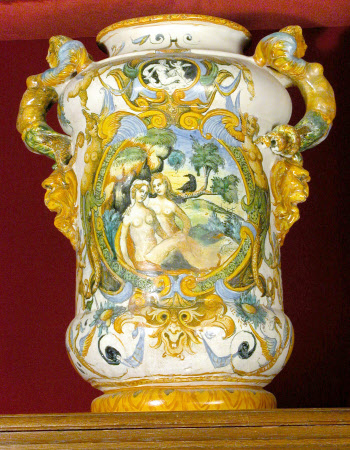Drug jar
Patanazzi
Category
Ceramics
Date
1585 - 1620
Materials
earthenware, tin-opacified lead glaze, polychrome pigments
Measurements
546 mm (Height)
Place of origin
Urbino
Order this imageCollection
Knightshayes Court, Devon
NT 540419
Summary
Drug jar, one of a pair (NT 540394), earthenware with tin-glaze (maiolica), straight-sided, with handles in the form of harpies (winged female figures) above lion-type masks, attributable to the Patanazzi Workshop, Urbino, late 16th or early 17th century; the central cartouche painted with a scene from Ovid’s Metamorphoses, Book II, 531-632: when the nymph, Coronis, pregnant with Apollo’s child, is unfaithful and discovered by a raven, who wants to warn Apollo, although a crow advises him not to, above, a smaller cartouche painted in black with Venus and Cupid, against a ground with grottesche with amorini.
Full description
The scene on the large drug jar from Ovid’s Metamorphes, is sometimes known as ‘The Gossiping Crow’. It depicts a naked Coronis, the lover of Apollo, betraying him with another man and she becomes pregnant. She is observed by a raven resting on a branch, who flies off to report it to Apollo, but is intercepted by a crow who warns him of upsetting Apollo, yet he proceeds and in his anger Apollo has Coronis killed and curses the raven turning his feathers black. Her child is Asclepius (Aesculapius), the healer. The source of the image is perhaps based on a print by Hendrik Goltzius, published by C.J. Visscher in 1590 (See British Museum, inv. no. 1947,1022.26). This pair of drug jars is similar to two large jars with maiolica covers surmounted by griffins (71 cm. high) at the Palazzo Apostolico in the pilgrimage town of Loreto, where there is a famous pharmacy set. The large covered jars were perhaps part of a later addition to the set attributed to the Patanazzi family, received from Urbino in 1631, however, this has since been questioned (J.V.G. Mallet correspondence 13/01/04). The quality of the draftsmanship on the Knightshayes jars, however, is somewhat superior, suggesting they may have been from another order, probably earlier. The appearance of a coronet on one of the jars (NT 540394), suggests they were part of a commission for a nobleman, rather than an ecclesiastical pharmacy. Details of the naked bodies were scraped off and repainted in the nineteenth century. See Floriano Grimaldi, Loreto, Palazzo Apostolico, (Bologna, 1977), p. 104, Nos. 636 and 637; and Mallet, Treasure Houses (1985) p. 573. From the large collection formed in the mid-19th century by the antiquarian Reverend Thomas A. Berney (1815-1895), of Bracon Hall, Norfolk; by descent to Miss Berney, sold at Sotheby & Co., London, Catalogue of Fine Italian Majolica, 18 June 1946, the first two items of three in lot 6, ‘A pair of large Albarelli of cylindrical shape with winged caryatid and mask handles, painted on both sides with lovers and putti in panels bordered with cornucopiæ and caryatids, 21 in.; and another with a siege on one side and a sacrifice on the reverse, 20in. (repaired), mid-16th Century’. The lot purchased for 10 guineas (£10.10s.00d.) at the Berney sale by "Sir J Amory", Sir John Heathcoat-Amory (1894-1972), 3rd Bt., of Knightshayes Court; the house, part of the collection, the garden Sir John and Lady Heathcoat-Amory created, and part of the estate were bequeathed to the National Trust by Sir John Heathcoat-Amory in 1972. The maiolica was later given by Joyce, Lady Heathcoat-Amory (1901-1997), née Wethered, a celebrated golfer. Exhibition history: London, South Kensington Museum, 1862, Special Exhibition of Works of Art of the Medieval Renaissance, and more recent periods, No. 5622; and Washington, D.C., National Gallery of Art, The Treasure Houses of Britain. 500 years of Private Patronage and Art Collecting, 3 November 1985 – 16 March 1986, No. 511 Publications: Jackson-Stops, Gervase (ed.). The Treasure Houses of Britain. 500 years of Private Patronage and Art Collecting, (Washington and New Haven, 1985), p. 573, Cat. No. 511.
Provenance
exhibited Washington cat. p.573 and 511 From Lady Amory
Makers and roles
Patanazzi, potter
